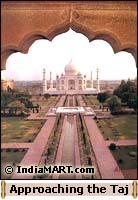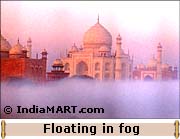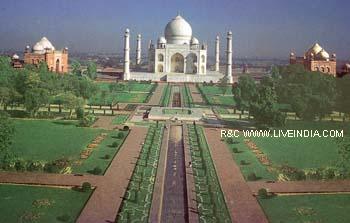|
BELIEVE IT OR NOT !!
The
Story of a Second Taj Many scholars, however, believe that this idea belongs to fiction rather than history. The traces which are identified as the foundations of the second Taj are actually the enclosing wall of a garden founded by Baber. The irregular position of Shah Jehan's cenotaph in comparison to Mumtaz Mahal's, is similar to that at the tomb of Itmad-ud-Daulah, and thus should not be of any striking significance. Besides, according to Islamic law, bodies are buried with their faces towards Mecca and legs towards the south, and the husband is placed on the right hand side of his wife. The interpretation that the cenotaph of Shah Jehan was not meant to be placed here appears to be superfluous. The Taj was designed by an Italian Architect
During the reign of Jehangir, a goldsmith named Veroneo did in fact come to India and, as mentioned by Father Manrique, did die on his way to Lahore. He lived for a time in Agra, and prospered there. He knew many influential Europeans throughout the North Indian provinces, and when he died, he was buried in the Christian cemetery of Padres Santos in Agra. The theory that Veroneo designed the Taj is intriguing and still finds occasional champions, especially in Italy. But the scales of evidence weigh heavily against it. True there is the testimony of Father Manrique, but he was no more than a casual tourist who heard that the Taj had been built by an Italian. However, nowhere else is mention made of Veroneo's participation in planning the Taj Mahal. As a matter of fact, there is no record that Veroneo had any skill other than that of working gold. Other Europeans who saw the Taj under construction never mentioned his name, and furthermore, it is difficult to suppose that an artist trained in seventeenth century Italy, the Italy of Bernini, could build a mausoleum that would typify Indo-Persian architecture. The Taj is not an isolated phenomenon, the creation of a single mastermind but the glorious consummation of a great epoch of art. The Basement Chambers and a probable Third Grave
This crypt would have contained the third and the real set of graves. The custom of providing cenotaphs or replicas had been followed by the Turks and the Mughals alike as we meet with this practice at the tomb of Iltutmish at Delhi and at the tombs of Saqid Khan and Akbar at Agra. The tomb of Akbar has three tombstones, one on the grave and two as cenotaphs. The tomb of Itmad-ud-Dauhlah and Chini-ka-Rauza too had three tombstones each. The lowest of the former was contained in a crypt which was originally accessible from the riverside and has now been completely blocked up. These examples indicate that the Mughals liked to provide three tombstones in a mausoleum. At the Taj, the third is traditionally claimed to exist. It is only in these underground vaults that the third set could have been placed. The doors in the basement corridor no doubt exist and must have originally given entry to some underground arrangement of chambers and corridors. Though they are now impregnably blocked, their existence lends weight to the legendary version. The
Taj Mahal was a Rajput Palace!! The
Taj is sinking!! Some very important facts resulted from this survey. It was discovered that the plinth of the mausoleum on the northern side (or the riverside) is lower than on the south by 3.5cms. Cracks were not noticed on the exterior wall, but they were definitely present on the second storey vaults of the marble structure and, on a much larger scale, in the underground vaults below the northern side. The long series of cracks in the underground vaults may be due to the crushing of lime on account of the excessive weight, or as seems more probable, this may be due to the sinking of the whole structure towards the riverside!! Such a sinking would shift the load out of balance slowly and gradually and the unequal settlement would crack the weak points, particularly the soffits of the vaults and arches, which is actually happening in the underground chambers. A structure which stands on the edge of water has a natural tendency to move towards the more open side, the higher edge always acting as a strong buttress, thrusting it in the opposite direction. It is the whole mass, and not a part of it, that is gradually sinking. This is what can justifiably be concluded from the available data. Getting There |Design & Layout|Inside the Taj |Taj Mahal Pictures Gallery Home Page View of Taj Mahal from different angles
|


